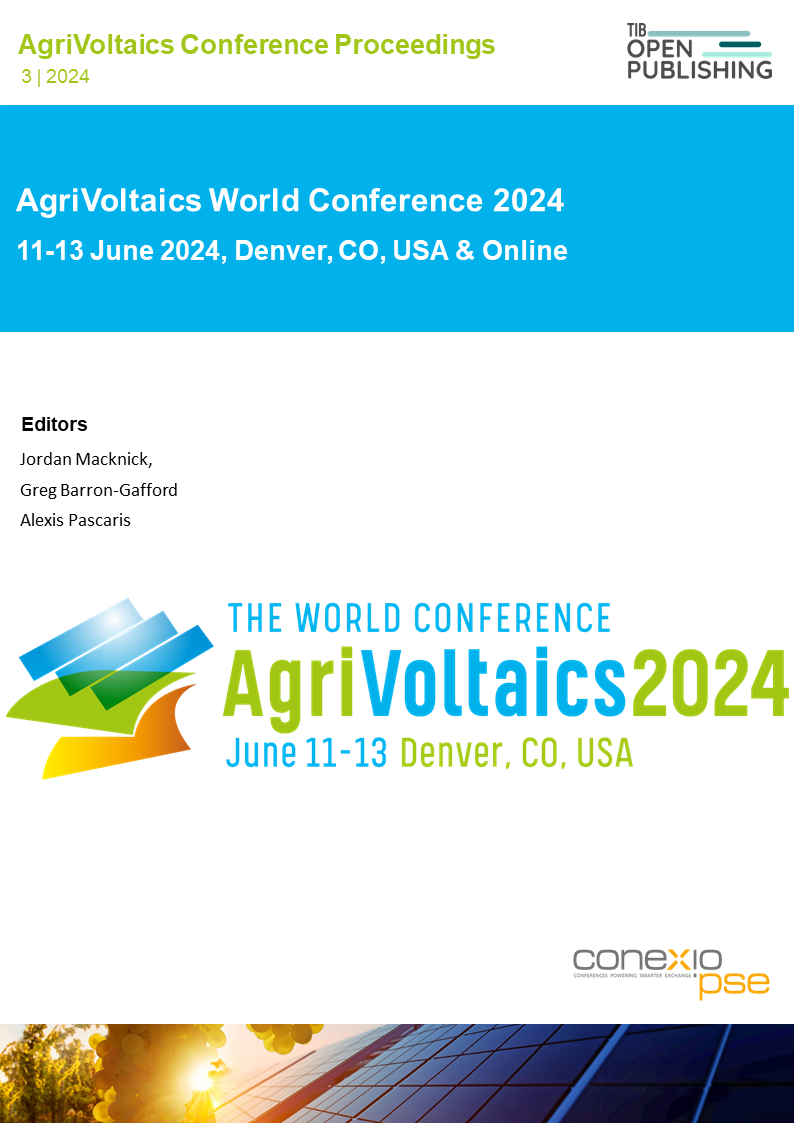Modeling the Agrivoltaic Potential for Land-Intensive Commodity Crops
DOI:
https://doi.org/10.52825/agripv.v3i.1368Keywords:
Crop Modeling, Maize, Agrivoltaic SystemAbstract
Corn and soybean farming use about two-thirds of the agricultural land in the US. To accelerate the large-scale adoption of agrivoltaics, best practices that are compatible with traditional farming operations for corn and soybeans need to be developed. In this presentation, we present the development of a modeling framework to explore the benefits and trade-offs between crop growth and photovoltaic (PV) electricity generation for common commodity crops at the county level. Our model couples a crop growth model, a soil water balance model, and a PV model in one integrated scheme. As an example, we consider corn growth in Renville County, MN. The model suggests that there is a ~0.55% loss in crop yield upon 1% shading because the crop-diminishing effect of reduced radiation is partially offset by increased water retention in the ground.
Downloads
References
R. I. Cuppari, C. W. Higgins, and G. W. Characklis, “Agrivoltaics and weather risk: A di-versification strategy for landowners,” Appl. Energy, vol. 291, no. February, p. 116809, Jun. 2021, doi: 10.1016/j.apenergy.2021.116809.
H. Dinesh and J. M. Pearce, “The potential of agrivoltaic systems,” Renew. Sustain. En-ergy Rev., vol. 54, pp. 299–308, Feb. 2016, doi: 10.1016/j.rser.2015.10.024.
K. W. Proctor, G. S. Murthy, and C. W. Higgins, “Agrivoltaics align with green new deal goals while supporting investment in the us’ rural economy,” Sustain. Switz., vol. 13, no. 1, pp. 1–11, 2021, doi: 10.3390/su13010137.
M. Laub, L. Pataczek, A. Feuerbacher, S. Zikeli, and P. Högy, “Contrasting yield respons-es at varying levels of shade suggest different suitability of crops for dual land-use sys-tems: a meta-analysis,” Agron. Sustain. Dev., vol. 42, no. 3, p. 51, Jun. 2022, doi: 10.1007/s13593-022-00783-7.
T. Sekiyama and A. Nagashima, “Solar sharing for both food and clean energy produc-tion: Performance of agrivoltaic systems for corn, a typical shade-intolerant crop,” Envi-ron. - MDPI, vol. 6, no. 6, 2019, doi: 10.3390/environments6060065.
H. Jo et al., “Comparison of Yield and Yield Components of Several Crops Grown under Agro-Photovoltaic System in Korea,” Agriculture, vol. 12, no. 5, p. 619, Apr. 2022, doi: 10.3390/agriculture12050619.
National Aeronautics and Space Administration (NASA) Prediction of Worldwide Energy Resource (POWER) Project v2.0.0, “National Aeronautics and Space Administration (NASA) Prediction of Worldwide Energy Resource (POWER) Project v2.0.0.” 2023. Ac-cessed: Aug. 18, 2023. [Online]. Available: https://power.larc.nasa.gov/data-access-viewer/
N. Brisson et al., “An overview of the crop model stics,” Eur. J. Agron., vol. 18, no. 3–4, pp. 309–332, Jan. 2003, doi: 10.1016/S1161-0301(02)00110-7.
J. W. Jones et al., “The DSSAT cropping system model,” Eur. J. Agron., vol. 18, no. 3–4, pp. 235–265, Jan. 2003, doi: 10.1016/S1161-0301(02)00107-7.
C. Zhao et al., “A SIMPLE crop model,” Eur. J. Agron., vol. 104, pp. 97–106, Mar. 2019, doi: 10.1016/j.eja.2019.01.009.
P. Woli, J. W. Jones, K. T. Ingram, and C. W. Fraisse, “Agricultural Reference Index for Drought (ARID),” Agron. J., vol. 104, no. 2, pp. 287–300, Mar. 2012, doi: 10.2134/agronj2011.0286.
C. H. B. Priestley and R. J. Taylor, “On the Assessment of Surface Heat Flux and Evaporation Using Large-Scale Parameters,” Mon. Weather Rev., vol. 100, no. 2, pp. 81–92, Feb. 1972, doi: 10.1175/1520-0493(1972)100<0081:OTAOSH>2.3.CO;2.
B. Y. H. Liu and R. C. Jordan, “The interrelationship and characteristic distribution of direct, diffuse and total solar radiation,” Sol. Energy, vol. 4, no. 3, pp. 1–19, Jul. 1960, doi: 10.1016/0038-092X(60)90062-1.
USDA Economic Research Service, "Commodity Costs and Returns". [Online]. Availa-ble: https://www.ers.usda.gov/data-products/commodity-costs-and-returns/
Published
How to Cite
Conference Proceedings Volume
Section
License
Copyright (c) 2025 Uwe Kortshagen, Vivian Ferry

This work is licensed under a Creative Commons Attribution 4.0 International License.
Accepted 2025-02-25
Published 2025-04-15
